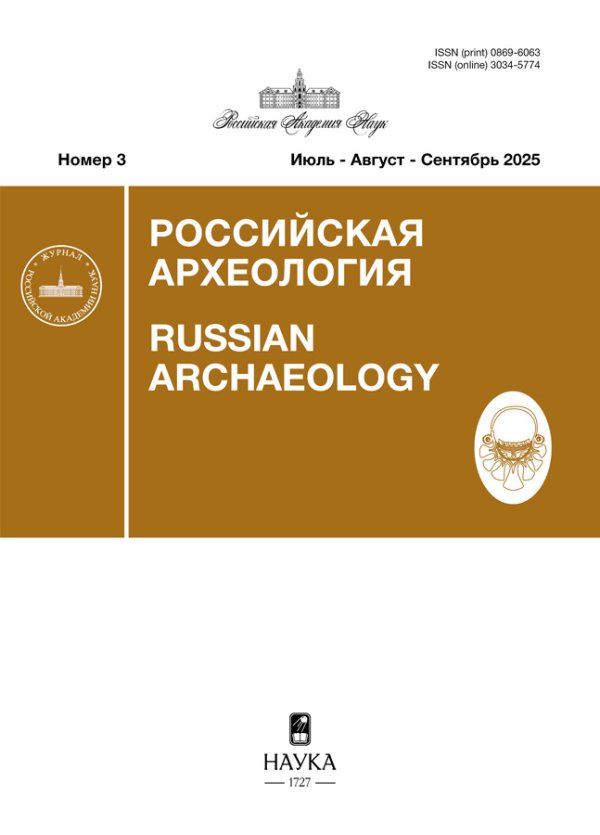THE PERSPECTIVES OF NESSANA: NEW STUDIES OF THE “CARAVAN CITY” IN SOUTHERN ISRAEL
- Authors: Tchekhanovets Y.1
-
Affiliations:
- Ben-Gurion University of the Negev
- Issue: No 2 (2023)
- Pages: 121-130
- Section: TO THE 75th ANNIVERSARY OF L. A. BELYAEV
- URL: https://journals.rcsi.science/0869-6063/article/view/138899
- DOI: https://doi.org/10.31857/S0869606323020058
- EDN: https://elibrary.ru/RFICRC
- ID: 138899
Cite item
Full Text
Abstract
The article discusses a new project for the archaeological study of ancient Nessana, a small settlement of the Byzantine and early Islamic period (5th–7th centuries AD), located in Southern Israel, in the southwestern part of the Negev desert. The heyday of the settlement is connected with its location: in the Byzantine period, Nessana became an important caravan junction on the way of the Christian pilgrimage from the Holy Land to Sinai, to the monastery of St. Catherine. Using all the economic benefits of pilgrimage, Nessana was turning into a large urbanized settlement with a population of about five thousand people, with numerous churches and caravanserais. Pilgrimage undoubtedly played an important role in the life of the settlement, which is clearly reflected in the evidence of papyri of the 5th–7th centuries AD found there in the 1930s. The favorable location of the site on the very edge of the desert, many churches, papyri, building inscriptions and pilgrimage graffiti in several languages, as well as an arid climate conducive to the preservation of organic materials, make Nessana a unique object for studying the archaeological problems of the early Christian pilgrimage. Despite intensive work carried out in Nessana by two archaeological expeditions, the stratigraphy of the site and its layout are still unclear. The article presents the preliminary results of the first season of fieldwork of the new Nessana expedition and considers a number of issues related to the further study of the site.
Keywords
About the authors
Yana Tchekhanovets
Ben-Gurion University of the Negev
Author for correspondence.
Email: yanatchk@gmail.com
Israel, Ber-Sheva
References
- Avni G., 2008. The Byzantine – Islamic Transition in the Negev: The Archaeological Perspective. Jerusalem Studies in Arabic and Islam, 35, pp. 1–26.
- Avni G., 2014. The Byzantine – Islamic Transition in Palestine: An Archaeological Approach. Oxford. 448 p.
- Bar-Oz G., Weissbrod L., Erickson-Gini T. et al., 2019. Ancient Trash Mounds Unravel Urban Collapse a Century before the End of Byzantine Hegemony in the Southern Levant. Proceedings of National Academy of Sciences. 116 (17), pp. 8239–8248.
- Betzer P., 2021. Nessana Necropoleis: An Aerial and Ground Survey of Byzantine Era Cemeteries in the Israeli Negev. Antigua Oriente, 19, pp. 277–300.
- Bitton-Ashkelony B., 2005. Encountering the Sacred: The Debate on Christian Pilgrimage in Late Antiquity. Berkeley. 270 p.
- The Blessings of Pilgrimage. P. Ousterhout, ed. Urbana, 1990. 150 p.
- Dahari U., 2000. Monastic Settlements in Southern Sinai in the Byzantine Period: The Archaeological Remains. Jerusalem. 250 p. (Israel Antiquities Authority Reports Reports, 9).
- Di Segni L., 2020. Epigraphic Evidence for Pilgrimage to the Holy Places. Pilgrimage to Jerusalem: Journeys, Destinations, Experiences Across Times and Cultures. F. Daim, ed. Mainz, pp. 23–30.
- Excavations at Nessana, 1. Auja Hafir, Palestine. H.D. Colt, ed. London: British School of Archaeology in Jerusalem, 1962. 311 p.
- Excavations at Nessana, 2. Literary Papyri. L. Casson, E.L. Hettich, eds. Princeton: Princeton University, 1950. 176 p.
- Excavations at Nessana, 3. Non-Literary Papyri C.J. Kraemer, ed. Princeton: Princeton University, 1958. 335 p.
- Figueras P., 1995. Monks and Monasteries in the Negev Desert. Liber Annuus, 45, pp. 401–450.
- Figueras P., 2004. Greek Inscriptions from Nessana. Nessana: Excavations and Studies, 1. D. Urman, ed. Beer-Sheva, pp. 222–242.
- Fuks D., Bar-Oz G., Tepper Y., Langgut D., Weissbrod L., Weiss E., 2021. The Rise and Fall of Viticulture in the Late Antique Negev Highlands Reconstructed from Archaeobotanical and Ceramic Data. Proceedings of National Academy of Sciences, 117, 33, pp. 19780–19791.
- Goldfus H., Arubas B., Bowes K., 2000. New Excavations in the East Church at Halutza (Elusa): Preliminary Report. Journal of Roman Archaeology, 13, pp. 331–342.
- Goldfus H., Fabian P., 2000. Haluza (Elusa). Excavations and Surveys of Israel, 111, pp. 93–94.
- Hoyland R., 2015. The Protection (Dhimma) of God and Muhammad in Early Islam: P. Nessana 77 Re-discovered. Islamic Cultures, Islamic Contexts: Essays in Honor of Professor Patricia Crone. B. Sadeghi, ed. Leiden; Boston, pp. 51–71.
- Hoyland R., 2021a. P. Nessana 56: A Greek-Arabic Contract from the Early Islamic Palestine and its Context. Jerusalem Studies in Arabic and Islam, 51, pp. 133–148.
- Hoyland R., 2021b. The Arabic Papyri from Early Islamic Nessana. Israel Exploration Journal, 71, 2, pp. 224–241.
- Hunt E.D., 1982. Holy Land Pilgrimage in the Later Roman Empire, AD 312–460. Oxford: Clarendon Press. 269 p.
- Huntington E., 1911. Palestine and its Transformation. Boston; New York. 444 p.
- Kirk G.E., Welles C.B., 1962. The Inscriptions. Excavations at Nessana, 1. Auja Hafir, Palestine. H.D. Colt, ed. London: British School of Archaeology in Jerusalem, pp. 131–197.
- Kristensen T.M., 2012. The Material Culture of Roman and Early Christian Pilgrimage. HEROM, 1, pp. 67–78.
- Külzer A., 2020. Pilgrims on their Way in the Holy Land: Roads and Routes According to Byzantine and Post-Byzantine Travel Accounts. Pilgrimage to Jerusalem: Journeys, Destinations, Experiences Across Times and Cultures. F. Daim, ed. Mainz, pp. 11–22.
- Lagrange F.M., 1897. De ‘Ain Kseimeh à Gaza. Revue Biblique, 6, pp. 614–615.
- Langgut D., Tepper Y., Benzaquen M., Erickson-Gini T., Bar-Oz G., 2021. Environment and horticulture in the Byzantine Negev Desert, Israel: sustainability, prosperity and enigmatic decline. Quaternary International, 593-594, pp. 160–177.
- Magness J., 2003. The Archaeology of the Early Islamic Settlement in Palestine. Winona Lake. 240 p.
- Maravale P., 1985. Lieux saints et pèlerinages d’Orient: histoire et géographie des origines a la conquête arabe. Paris.
- Marom N., Meiri M., Tepper Y., Erickson-Gini T., Recife H., Weissbrod L., Bar-Oz G., 2019. Zooarchaeology and the Social and Economic Upheavals of Late Antique – Early Islamic Sequence of the Negev Desert. Scientific Reports, 9, 6702.
- Mayerson P., 1962. The Ancient Agricultural Regime of Nessana and the Central Negeb. Excavations at Nessana, 1. Auja Hafir, Palestine. H.D. Colt, ed. London: British School of Archaeology in Jerusalem, pp. 211–269.
- Mayerson P., 1982. The Pilgrim Routes to Mount Sinai and the Armenians. Israel Exploration Journal, 32, pp. 44–57.
- Musil A., 1907. Arabia Petraea II. Edom. Vienna.
- Negev A., 1977. The Inscriptions of Wadi Haggag, Sinai. Jerusalem: Institute of Archaeology, Hebrew University. 100 p. (Qedem, 6).
- Nessana: Excavations and Studies. D. Urman, ed. Beer Sheva, 2004. 250 p.
- Pilgrimage in the Byzantine Empire: 7th to 15th centuries: Dumbarton Oaks Symposium, 5–7 May 2000. Dumbarton Oaks Papers, 2002, 56, pp. 59–241.
- Pogorelsky O., Stone M.E., Tchekhanovets Y., 2019. Armenians in the Negev: Evidence from Nessana. Le Muséon, 132, 1–2, pp. 123–137.
- Ruffini G., 2011. Village Life and Family Power in Late Antique Nessana. Transactions of the American Philological Association, 141, 1, pp. 201–225.
- Schöne C.A., Erickson-Gini T., Jordan F., Heinzelmann M., 2019. Elusa (I): Vorbericht zur Grabungs- und Surveykampagne 2019. Kölner und Bonner Archaeologica, 8 (2018), pp. 71–90.
- Shereshevski J., 1991. Byzantine Urban Settlements in the Negev Desert. Beer-Sheva. 277 p. (Beer-Sheva, V).
- Stone M.E., 1982. The Armenian Inscriptions from the Sinai. Cambridge. 250 p. (Harvard Armenian Texts and Studies, 6).
- Stone M.E., 1986. Holy Land Pilgrimage of Armenians before the Arab Conquest. Revue Biblique, 93, pp. 93–110.
- Stone M.E., 2017. Uncovering Ancient Footprints: Armenian Inscriptions and the Pilgrimage Routes of the Sinai. Atlanta. 203 p.
- Stroumsa R., 2008. People and Identities in Nessana: PhD Dissertation, Duke University.
- Tchekhanovets Y., 2011. Early Georgian Pilgrimage to the Holy Land. Liber Annuus, 61, pp. 453–471.
- Tchekhanovets Y., 2014. Miniature Diptych from Jerusalem. Bizantinische Zeitschrift, 107, 2, pp. 893–902.
- Tchekhanovets Y., 2019. Ring with Resurrection Scene from Umayyad Jerusalem. Electrum, 26, pp. 177–185.
- Tchekhanovets Y., 2023. Nessana, 2022. Hadashot Arkheologiyot – Excavations and Surveys in Israel, 134.
- Tchekhanovets Y., Jojua T. Georgian inscription from Nessana. (Forthcoming).
- Tchekhanovets Y., Rasiuk A., Levy A., Peretz A., Pogorelsky O., 2023. The Renewed Excavations at Nessana. Archaeological Excavations and Research Studies in Southern Israel. 19th Annual Southern Conference. A. Golani, ed. Beer-Sheva. (Hebrew).
- Tchekhanovets Y., Tepper Y., Bar-Oz G., 2017. The Armenian Graffito from the Southern Church of Shivta. Revue Biblique, 124, pp. 446–454.
- Tepper Y., Bar-Oz G., 2019. Shivta. Hadashot Arkheologiyot – Excavations and Surveys in Israel, 131.
- Whately C., 2016. Camels, Soldiers, and Pilgrims in Sixth Century Nessana. Scripta Classica Israelica, 35, pp. 121–135.
- Wilkinson J., 1977. Jerusalem Pilgrims before the Crusades. Warminster. 225 p.
- Woolley C.L., Lawrence T.E., 1915. The Wilderness of Zin. London. 160 p. (Palestine Exploration Fund. Annual, 1914–1915).
- Yasin A.M., 2012. Response: Materializing the Study of Late Antique Pilgrimage. HEROM, 1, pp. 261– 275.
Supplementary files

















